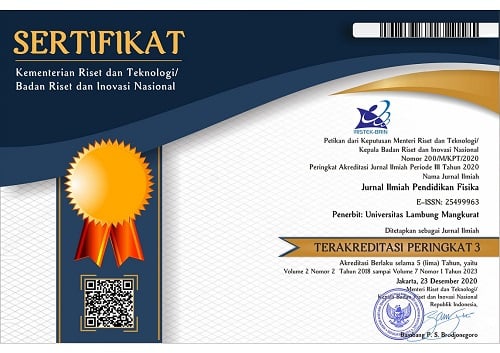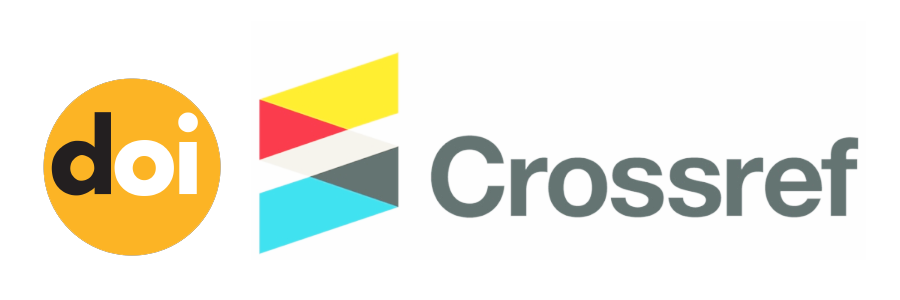Pengembangan dan Validasi Angket Motivasi Belajar Fisika (AMBF): Studi Pilot
Abstract
Tujuan penelitian ini adalah untuk mengembangkan dan menghasilkan angket motivasi belajar fisika (AMBF) yang layak digunakan untuk mengukur motivasi siswa. Angket ini terdiri dari 40 pernyataan dengan 7 aspek motivasi meliputi ketertarikan belajar fisika, strategi belajar, faktor lingkungan belajar, faktor guru, fakor media, karir, dan self-efficacy. Setiap pernyataan angket terlebih dahulu divalidasi oleh ahli diantaranya bahasa, psikologi, dan pendidikan fisika. Selanjutnya, angket diberikan kepada 150 orang siswa sekolah menengah atas di kota Pontianak. Berdasarkan uji statistik diperoleh nilai Cronbach Alpha sebesar 0,91 dengan kategori sangat baik. Respon siswa menunjukkan bahwa sebagian besar siswa (70%) setuju bahwa siswa senang belajar fisika karena mempelajari kejadian-kejadian (fenomena) dalam kehidupan sehari-hari. Kemudian sekitar 75% dari responden menyatakan bahwa siswa senang belajar fisika karena guru menggunakan alat peraga ketika mengajar. Sekitar 80% siswa merespon bahwa mereka lebih memilih belajar secara tatap muka dibanding secara daring. Terakhir, sekitar 70% siswa menyatakan bahwa mereka belajar fisika dengan sungguh-sungguh agar dapat diterima di perguruan tinggi. Berdasarkan hasil studi pilot, angket motivasi belajar fisika ini layak digunakan untuk skala yang lebih besar.
This study aims to develop and generate a physics learning motivation survey that will be used to measure students’ motivation. This survey has 40 items and covers seven motivational aspects: interest in learning physics, learning strategies, learning environment, teachers’ factors, media factors, future carrier, and self-efficacy. Firstly, each survey item is validated by experts: language, psychology, and physics education. Then the survey is administered to 150 senior high school students in Pontianak. Based on statistical analysis, the coefficient of Alpha Cronbach is 0.91, which is very good. Students’ responses show that most students (70%) agree that they like to learn physics because it covers phenomena daily. Then about 75% of the respondents enjoy learning physics because their teachers use tools (kit) for teaching. About 80% of the students choose to learn in the classroom (face to face) than virtual learning (online). Lastly, about 70% of students respond that they are motivated to learn physics to be accepted at universities. Based on a pilot study, a physics learning motivation survey is valid for a large-scale population.
Keywords
Full Text:
PDFReferences
Abraham, J., & Barker, K. (2015). Exploring gender difference in motivation, engagement and enrolment behaviour of senior secondary physics students in new south wales. Research in Science Education, 45(1), 59–73. https://doi.org/https://doi.org/10.1007/s11165-014-9413-2
Angell, C., Guttersrud, Ø., Henriksen, E. K., & Isnes, A. (2004). Physics: Frightful, but fun. pupils’ and teachers’ views of physics and physics teaching. Science Education, 88(5), 683–706.
Barniol, P., & Zavala, G. (2014). Test of understanding of vectors: A reliable multiple-choice vector concept test. Physical Review Special Topics - Physics Education Research, 10(1). https://doi.org/https://doi.org/10.1103/PhysRevSTPER.10.010121
Burkholder, E. W., Miles, J. K., Layden, T. J., Wang, K. D., Fritz, A. V, & Wieman, C. E. (2020). Template for teaching and assessment of problem solving in introductory physics. Physical Review Physics Education Research, 16(1). https://doi.org/https://doi.org/10.1103/PHYSREVPHYSEDUCRES.16.010123
Ceberio, M., Almudí, J. M., & Franco, Á. (2016). Design and application of interactive simulations in problem-solving in university-level physics education. Journal of Science Education and Technology, 25(4), 590–609. https://doi.org/https://doi.org/10.1007/s10956-016-9615-7
Cohen, L., Manion, L., & Morrison, K. (2018). Research methods in education (8th ed.). Routledge: Taylor & Francis Group.
Cortina, J. M. (1993). What is coefficient alpha? An examination of theory and applications. Journal of Applied Psychology, 78, 98–104.
Cronbach, L. J., & Shavelson, R. J. (2004). My Current thoughts on coefficient alpha and successor procedures. Educational and Psychological Measurement, 64(3), 391–418. https://doi.org/https://doi.org/10.1177/0013164404266386
Docktor, J. L., Strand, N. E., Mestre, J. P., & Ross, B. H. (2015). Conceptual problem solving in high school physics. Physical Review Special Topics - Physics Education Research, 11(2). https://doi.org/https://doi.org/10.1103/PhysRevSTPER.11.020106
Elizabeth, W., & Malcolm, P. (1999). Real-life contexts for learning physics: meanings, issues and practice. Physics Education, 34(68).
Etkina, E., Brookes, D. T., & Planinsic, G. (2021). The investigative science learning environment (ISLE) approach to learning physics. Journal of Physics: Conference Series, 1882. https://doi.org/https://doi.org/10.1088/1742-6596/1882/1/012001
Fox, M. F. J., Hoehn, J. R., Werth, A., & Lewandowski, H. J. (2021). Lab instruction during the COVID-19 pandemic: Effects on student views about experimental physics in comparison with previous years. Physical Review Physics Education Research, 17(1). https://doi.org/https://doi.org/10.1103/PhysRevPhysEducRes.17.010148
Glynn, S. M., Brickman, P., Armstrong, N., & Taasoobshirazi, G. (2011). Science motivation questionnaire II: Validation with science majors and nonscience majors. Journal of Research in Science Teaching, 48(10), 1159–1176. https://doi.org/https://doi.org/10.1002/tea.20442
Glynn, S. M., Taasoobshirazi, G., & Brickman, P. (2009). Science motivation questionnaire: Construct validation with nonscience majors. Journal of Research in Science Teaching, 46(2), 127–146. https://doi.org/https://doi.org/10.1002/tea.20267
Gungor, A., & de Cock, M. (2021). Validity of the physics affective characteristics scale for Flemish pharmacy and biology majors. Physical Review Physics Education Research, 17(1). https://doi.org/https://doi.org/10.1103/PhysRevPhysEducRes.17.010132
Hsu, L., Brewe, E., Foster, T. M., & Harper, K. A. (2004). Resource Letter RPS-1: Research in problem solving. American Journal of Physics, 72(9), 1147–1156. https://doi.org/https://doi.org/10.1119/1.1763175
Klein, P., Ivanjek, L., Dahlkemper, M. N., Jeličić, K., Geyer, M. A., Küchemann, S., & Susac, A. (2021). Studying physics during the COVID-19 pandemic: Student assessments of learning achievement, perceived effectiveness of online recitations, and online laboratories. Physical Review Physics Education Research, 17(1). https://doi.org/https://doi.org/10.1103/PhysRevPhysEducRes.17.010117
Kuo, E., Hull, M. M., Gupta, A., & Elby, A. (2013). How students blend conceptual and formal mathematical reasoning in solving physics problems. Science Education, 97(1), 32–57. https://doi.org/https://doi.org/10.1002/sce.21043
Pawlak, A., Irving, P. W., & Caballero, M. D. (2020). Learning assistant approaches to teaching computational physics problems in a problem-based learning course. Physical Review Physics Education Research, 16(1). https://doi.org/https://doi.org/10.1103/PHYSREVPHYSEDUCRES.16.010139
Pintrich, P. R., Smith, D. A. F., Garcia, T., & Mckeachie, W. J. (1993). Reliability and predictive validity of the motivated strategies for learning questionnaire (mslq). Educational and Psychological Measurement, 53(3), 801–813. Retrieved from https://doi.org/10.1177/0013164493053003024
Podolefsky, N. S., Perkins, K. K., & Adams, W. K. (2010). Factors promoting engaged exploration with computer simulations. Physical Review Special Topics - Physics Education Research, 6(2). https://doi.org/https://doi.org/10.1103/PhysRevSTPER.6.020117
Ryan, R. M., & Deci, E. L. (2000). Intrinsic and extrinsic motivations: classic definitions and new directions. Contemporary Educational Psychology, 25(1), 54–67. https://doi.org/https://doi.org/10.1006/ceps.1999.1020
Scheid, J., Müller, A., Hettmannsperger, R., & Schnotz, W. (2019). Improving learners’ representational coherence ability with experiment-related representational activity tasks. Physical Review Physics Education Research, 15(1). https://doi.org/https://doi.org/10.1103/physrevphyseducres.15.010142
Schunk, D. H., & DiBenedetto, M. K. (2020). Motivation and social cognitive theory. Contemporary Educational Psychology, 60. https://doi.org/https://doi.org/10.1016/j.cedpsych.2019.101832
Torio, A. G. (2015). Physics motivation and research: understanding the 21 st century learners of today. International Journal of Education and Research, 3(2). Retrieved from www.ijern.com
Tuan, H. L., Chin, C. C., & Shieh, S. H. (2005). The development of a questionnaire to measure students’ motivation towards science learning. International Journal of Science Education, 27(6), 639–654. https://doi.org/https://doi.org/10.1080/0950069042000323737
Velayutham, S., Aldridge, J., & Fraser, B. (2011). Development and validation of an instrument to measure students’ motivation and self-regulation in science learning. International Journal of Science Education, 33(15), 2159–2179. https://doi.org/https://doi.org/10.1080/09500693.2010.541529
DOI: https://doi.org/10.20527/jipf.v5i3.3829
Refbacks
- There are currently no refbacks.
Indexed by: Jurnal Ilmiah Pendidikan Fisika is licensed under a creative commons attribution-share alike 4.0 international license
Statistics Counter |
















